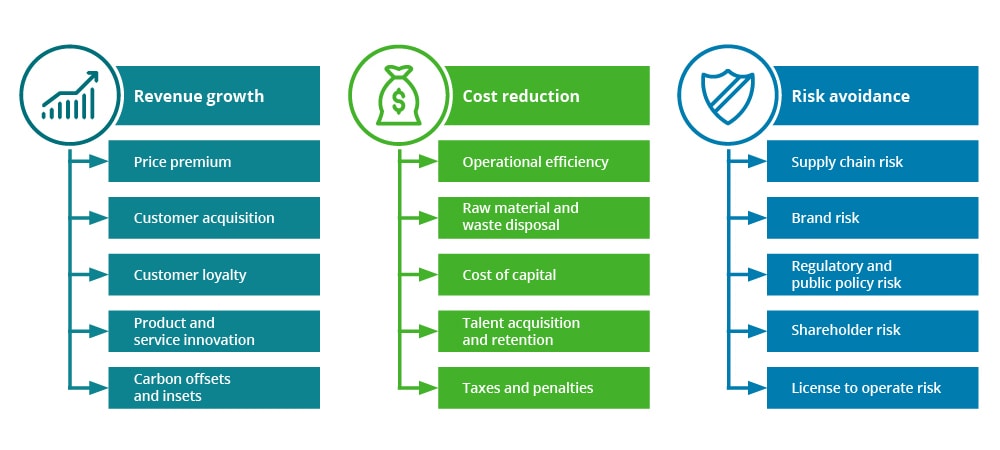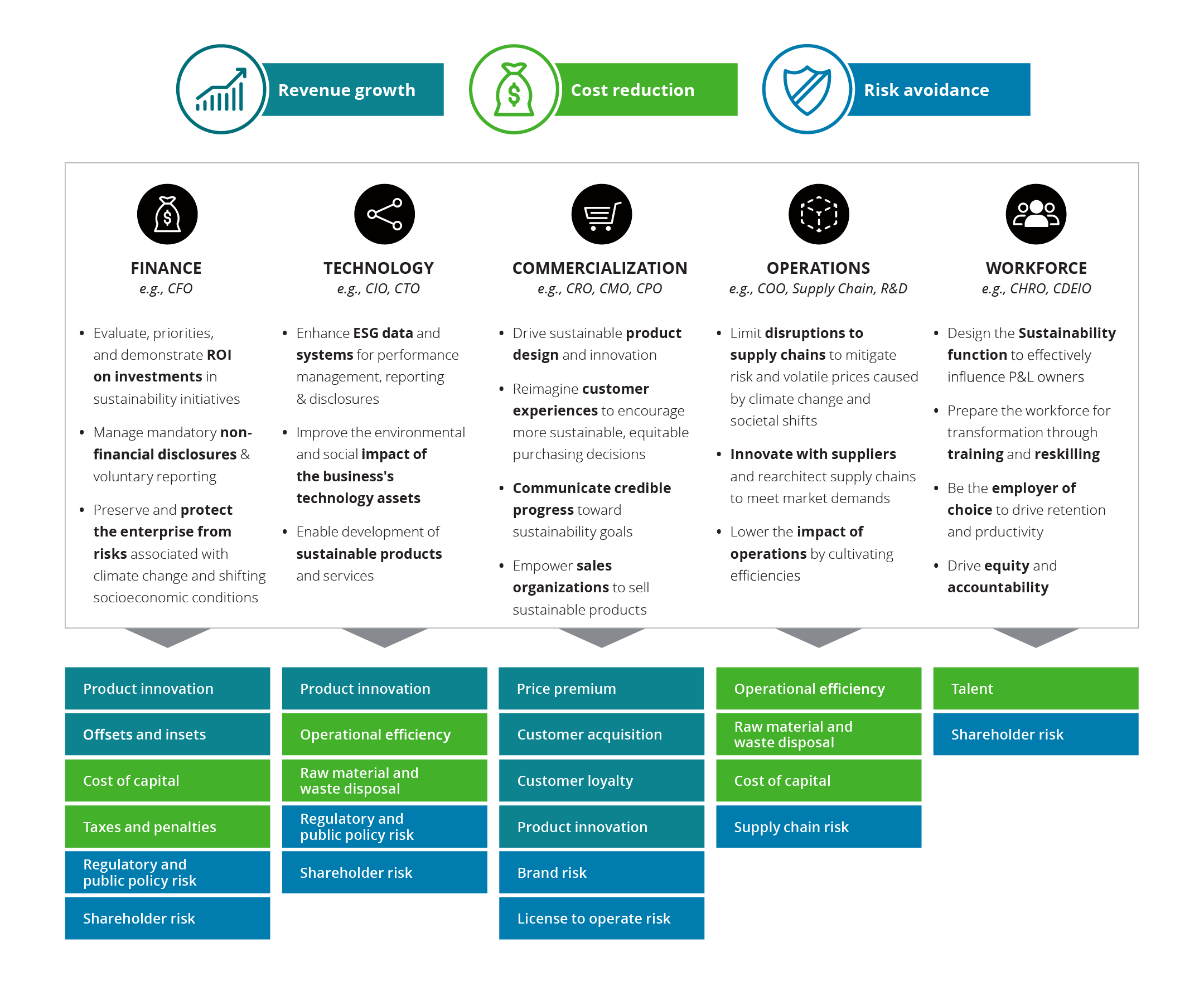The business case for sustainability has been saved

Perspectives
The business case for sustainability
Value creation and the path to profitable growth
Today’s companies find themselves at a sustainability inflection point. First movers are already embracing this way of doing business, helping people and the planet while boosting their bottom line. Others risk getting left behind.
The next big shift
Think back to the proliferation of the internet, resulting digital transformation, and the age of information. Imagine if companies like Blockbuster, Nokia, and Sears had prepared for this shift. What could they have done differently, and what would they look like today?
Today’s companies find themselves at a similar inflection point. A sustainability transition is already underway—one that has the potential to disrupt businesses and industries at a scale not seen since the early days of the internet.
Take energy, for example. Massive technological advancements and rapid scaling of associated supply chains over just the past few years have made it nearly three times cheaper in most parts of the world to build new solar generation capacity than to build a new coal power plant. Just 15 years ago, the opposite was true.1 And while legacy coal, oil, and gas facilities still account for 82% of the world’s energy consumption,2 more than 80% of new capacity now comes from renewable sources.3 Just as with the digital transformation, success today does not require predicting the future, but rather seizing the moment.
No longer a choice
A decade ago, few Fortune 500 companies were prioritizing sustainability. Today, that has shifted in the face of an unprecedented climate crisis and growing pressure to confront issues of inequality and inequity. Customers, community activists, employees, investors, and governments demand that businesses act and do better.
As regulatory requirements develop in the United States, Europe, and the rest of the world, corporate leaders now face the imperative to consider business risk and environmental, social, and governance (ESG) compliance alongside operational and financial performance. Organizations that embed sustainable business practices into their operations can gain efficiencies and optimize costs while meeting regulatory and stakeholder demands.
Additionally, sustainability presents a new lever for growth in a competitive environment often coupled with commoditized goods, fierce price competition, supply chain disruptions, and fickle customers. Companies that fail to recognize this (or take advantage of it) may be leaving money and market share on the table.
The cost of inaction
Headlines in recent years have been littered with companies that have not taken sustainability seriously. Such regulatory noncompliance has resulted in lawsuits and fines. Even more importantly, these infractions have the potential to create a lasting negative impact on a company’s brand and reputation. Studies, reports, and targeted social media campaigns from nonprofits and nongovernmental organizations (NGOs), like Break Free From Plastic,4 threaten to affect stock prices, customer sentiment, and the ability to recruit top talent.
Increasing social and environmental regulations have a direct impact on companies’ profitability and business operations. The Uyghur Forced Labor Prevention Act implemented in 2022 requires companies importing goods produced in certain parts of Asia to prove that inputs were not created with forced labor. More than $2.5 billion of electronics, apparel, footwear, and agricultural products have been held up by US Customs—creating stranded inventory and disrupting supply chains for companies that are not able to reliably trace products back to their second- or third-tier suppliers.5
Ultimately, the greatest cost of inaction comes through loss of market share to competitors that are innovating and effectively incorporating sustainability into their business and product strategy. For example, the largest automakers are still playing catch-up to Tesla, which accounted for 56% of passenger electric vehicles (EVs) in the United States in 2023.6 In retail, as consumer packaged goods companies battle for shelf space and share of customer wallets, historical market leaders are losing out to more eco-conscious brands that appeal to a new generation of customers.7
Making the case for profitable growth
The sustainability transition creates an opportunity to identify new revenue streams and optimize costs, positioning organizations for long-term, profitable growth that secures future market relevancy. Reliable evidence across sectors and industries shows that companies can meet their environmental and social goals while outperforming their competitors and driving positive top- and bottom-line growth.
It helps to evaluate the potential benefits of a sustainability initiative through the Sustainability Value Framework (figure 1). The framework starts with three categories most C-suite executives already focus on: revenue growth, cost reduction, and risk avoidance. The levers in each of these categories can then be used to construct a business case that demonstrates how sustainability can drive long-term growth and profitability for the business.
By using the Sustainability Value Framework, business leaders can evaluate opportunities and clearly articulate a case for investment to their cross-functional stakeholders, who are inevitably required to approve, plan, and execute on sustainability initiatives.

Embracing enterprisewide transformation
Launching sustainability initiatives can take on many forms. Some companies may opt to start their journey in a single part of their organization, such as waste reduction or energy management. In many organizations, a chief sustainability officer (CSO) or equivalent ESG/Purpose leader is responsible for defining a strategy, establishing goals, convening stakeholders, and driving progress. However, this is not for the CSO to solve independently; each function should contribute to the vision and partake in its execution. Maximizing benefits of a sustainability transformation requires C-suite sponsorship and an enterprisewide approach (figure 2).


Learn how each function of the enterprise can contribute to sustainable transformation and a profitable path forward.
Explore the roles finance, technology, commercialization, operations, and workforce play in advancing sustainable business practices and growing revenue, reducing costs, and avoiding risk.
Get in touch

Polina Markovich
Deloitte Consulting LLP
Sustainability (Climate & Equity)
Offerings

Senior Manager
Developer Experience &
Platform Engineering
Deloitte Consulting LLP
1 Max Roser, “Why did renewables become so cheap so fast?,” Our World in Data, December 1, 2020.
2 Hannah Ritchie and Pablo Rosado, “Energy mix,” Our World in Data, last updated January 2024.
3 Arvydas Lebdys et al., Renewable capacity statistics 2023, International Renewable Energy Agency (IRENA), March 2023.
4 Break Free From Plastic, Brand audit report 2023: Branded 6, February 1, 2024.
5 US Customs and Border Protection, “Uyghur Forced Labor Prevention Act statistics,” last updated May 15, 2024.
6 Zachary Shahan, “US EV market grows 29% in 4th quarter, Tesla holds 56% market share,” CleanTechnica, January 14, 2024.
7 Sarah Very, “The rise of eco-friendly consumer products puts pressure on P&G,” Bloomberg, October 4, 2016.
8 Leon Pieters et al., “Green products come of age,” Deloitte Insights, May 31, 2023.
9 Unilever, “Unilever’s purpose-led brands outperform,” press release, June 11, 2019.
10 Leah Johns et al., “How brands can sell to environmentally conscious nonconsumers,” Harvard Business Review, June 5, 2023.
11 McCann, “IKEA: ThisAbles,” accessed June 5, 2024.
12 Tensie Whelan and Carly Fink, “The comprehensive business case for sustainability,” Harvard Business Review, October 21, 2016.
13 Andrew Dalton, “Lockheed Martin’s bioenergy plant turns waste into clean power,” Engadget, updated September 22, 2016.
14 World Economic Forum, “Patagonia – Sparking the sustainability cultural shift at every level,” December 12, 2023.
15 Tensie Whelan et al., ESG and Financial Performance: Uncovering the relationship by aggregating evidence from 1,000 plus studies published between 2015 – 2020, NYU Stern Center for Sustainable Business, 2021.
16 Gary Hecimovich et al, “For CFOs, the full impact of the Inflation Reduction Act is still coming into focus,” CFO Insights, Deloitte, November 3, 2022.
17 National Academies of Sciences, Engineering, and Medicine; Policy and Global Affairs; Office of Special Projects; Committee on Building Adaptable and Resilient Supply Chains After Hurricanes Harvey, Irma, and Maria, “Overview of supply chain impacts from the 2017 hurricanes,” in Strengthening Post-Hurricane Supply Chain Resilience: Observations from Hurricanes Harvey, Irma, and Maria (Washington, D.C.: National Academies Press, 2020).
18 Marc Oman and Ignacio Fernandez Stearns, “24/7 carbon-free energy: Powering up new clean energy projects across the globe,” Google Cloud blog, April 21, 2022.
19 Center for Climate Integrity, “Cases underway to make climate polluters pay,” last revised February 22, 2024.
20 The Conference Board, 2023 proxy season review: Navigating ESG backlash & shareholder proposal fatigue, 2023.




